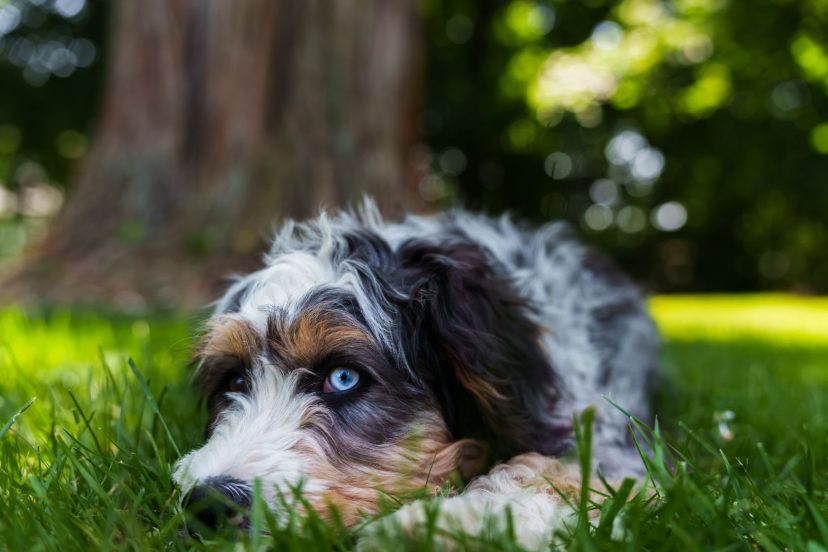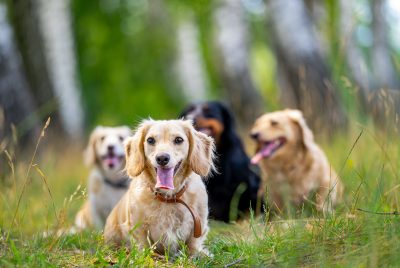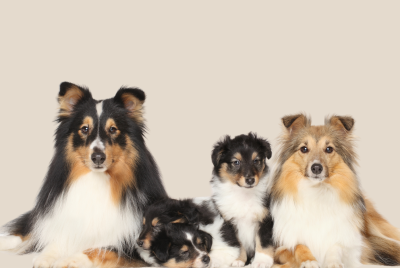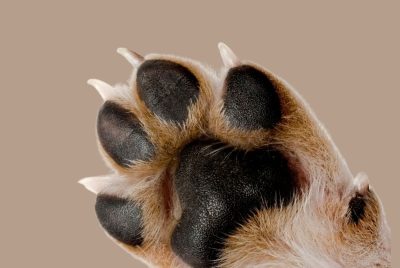Are Bernedoodle Hypoallergenic? What Does This Mean?
The Bernedoodle is a delightful cross of the Bernese Mountain and Poodle dogs that have become quite popular over the past few years. Cute-looking, kind-hearted, and intelligent, these are some common traits of Bernedoodles that have stolen many hearts. We all wonder what is “bernedoodle hypoallergenic” – let’s talk about what does this mean.
Hypoallergenic is one of the most frequent questions about this breed asked by people. In this well-researched article we shall take a deep dive into hypoallergenic dog breeds, outline the characteristics and history of Bernedoodles, and give an in-depth answer to whether they are genuinely hypoallergenic.
At the end of this article, you will be able to understand well and make a good decision about if a Bernedoodle is your choice pet especially when you or any other person in your family has allergy issues.
What Does Hypoallergenic Mean?
People often use the term “hypoallergenic” to refer to pets that are unlikely to cause allergic reactions. But, people should know that no breed of dog can be completely hypoallergic. Ordinarily, allergies occur because of proteins in a dog’s urine, dander (tiny flecks of skin), and saliva.
Such proteins may become air-lifted and adhere onto objects such as furniture, clothes or bedding. When an individual sensitive to dogs comes into contact with these proteins, their immune system might respond excessively resulting in symptoms like sneezing; itching; watery eyes etc.
Factors Influencing Hypoallergenic Qualities
Several factors can influence a dog’s hypoallergenic qualities, including:
- Coat Type: Dogs with hair-like coats that continuously grow, such as Poodles, tend to shed less dander compared to dogs with fur.
- Shedding Levels: Dogs that shed less hair tend to spread fewer allergens in the environment.
- Saliva Production: Some breeds may produce less saliva, reducing the amount of allergenic proteins in their saliva.
- Size: Smaller dogs produce fewer allergens simply because they have less surface area to shed dander and produce saliva.
The Bernedoodle: A Hybrid Breed
The Bernedoodle is a relatively new hybrid breed, first intentionally bred in the early 2000s. This crossbreed combines the best traits of its parent breeds, the Bernese Mountain Dog and the Poodle. The goal of creating the Bernedoodle was to produce a dog that possesses the intelligence and low-shedding coat of the Poodle with the gentle and loyal nature of the Bernese Mountain Dog.
The Bernese Mountain Dog is a large, sturdy breed with a calm and affectionate temperament. Originating from the Swiss Alps, Bernese Mountain Dogs were initially used as farm dogs for tasks such as pulling carts and herding cattle. They are known for their beautiful tri-color coats and friendly disposition.
The Poodle, on the other hand, is a highly intelligent and versatile breed that comes in three sizes: Standard, Miniature, and Toy. Poodles are renowned for their hypoallergenic coats, which are curly, dense, and shed minimally. They are also known for their agility and trainability.
Types of Bernedoodles
Bernedoodles come in various sizes, depending on the size of the Poodle parent. The three primary sizes are:
- Standard Bernedoodle: A cross between a Bernese Mountain Dog and a Standard Poodle, typically weighing between 70 to 90 pounds and standing 23 to 29 inches tall.
- Mini Bernedoodle: A cross between a Bernese Mountain Dog and a Miniature Poodle, usually weighing between 25 to 49 pounds and standing 18 to 22 inches tall.
- Tiny Bernedoodle: A cross between a Mini Bernedoodle and a Toy Poodle, typically weighing between 10 to 24 pounds and standing 12 to 17 inches tall.
Are Bernedoodles Hypoallergenic?
Role of Genetics
When considering whether Bernedoodles are hypoallergenic, it is crucial to understand the role of genetics. As a hybrid breed, Bernedoodles inherit traits from both parent breeds. The Poodle parent contributes the hypoallergenic coat, while the Bernese Mountain Dog parent may contribute a coat that sheds more and produces more dander.
The degree to which a Bernedoodle is hypoallergenic can vary significantly depending on which parent breed’s traits are more dominant in a particular puppy. Some Bernedoodles may inherit more of the Poodle’s low-shedding, hypoallergenic coat, while others may have a coat more similar to the Bernese Mountain Dog, which sheds more and produces more dander.
Coat Types in Bernedoodles
Bernedoodles can have different coat types, each of which can influence their hypoallergenic qualities. The three primary coat types are:
- Curly Coat: Resembling the Poodle’s coat, the curly coat is dense, tight, and sheds minimally. Bernedoodles with curly coats are typically the most hypoallergenic.
- Wavy Coat: A mix between the Poodle’s curls and the Bernese Mountain Dog’s straighter fur, the wavy coat sheds moderately and may produce more dander than the curly coat.
- Straight Coat: Similar to the Bernese Mountain Dog’s coat, the straight coat sheds more and is less likely to be hypoallergenic.
Grooming and Maintenance
Proper grooming and maintenance play a significant role in managing a Bernedoodle’s hypoallergenic qualities. Regular grooming can help reduce the amount of dander and loose hair, making the environment more comfortable for allergy sufferers. Grooming routines for Bernedoodles include:
- Brushing: Regular brushing helps remove loose hair and dander from the coat. Curly-coated Bernedoodles may require brushing multiple times a week, while wavy and straight-coated Bernedoodles may need less frequent brushing.
- Bathing: Bathing your Bernedoodle every 4 to 6 weeks can help keep their coat clean and reduce allergens. Use a hypoallergenic dog shampoo to minimize skin irritation.
- Professional Grooming: Regular visits to a professional groomer can help maintain the coat’s health and manage shedding. Groomers can also trim the coat to reduce the risk of matting and tangles.
Environmental Factors
In addition to grooming, managing the environment can help reduce allergens. Some tips for creating a hypoallergenic living space include:
- Cleaning: Regularly clean your home, including vacuuming carpets, upholstery, and curtains to remove dander and hair.
- Air Purifiers: Using air purifiers with HEPA filters can help capture airborne allergens and improve air quality.
- Pet-Free Zones: Designate certain areas of your home, such as bedrooms, as pet-free zones to reduce allergen exposure while sleeping.
Individual Sensitivity
It is important to note that individual sensitivity to allergens can vary. While some people with dog allergies may find that they can tolerate Bernedoodles with minimal issues, others may still experience allergic reactions. Spending time with a Bernedoodle before bringing one into your home can help determine if you or your family members are likely to have an allergic response.
Health and Well-Being of Bernedoodles
Common Health Issues
Like all dog breeds, Bernedoodles can be prone to certain health issues. Being aware of potential health problems can help you take proactive steps to ensure your Bernedoodle’s well-being. Some common health issues in Bernedoodles include:
- Hip Dysplasia: A genetic condition where the hip joint does not fit properly into the hip socket, leading to arthritis and pain. Regular exercise and maintaining a healthy weight can help manage this condition.
- Elbow Dysplasia: A similar condition to hip dysplasia, affecting the elbow joint. It can cause lameness and discomfort.
- Progressive Retinal Atrophy (PRA): A group of genetic eye disorders that lead to blindness. Regular eye check-ups can help detect PRA early.
- Allergies: Bernedoodles can be prone to allergies, including food and environmental allergies. Identifying and managing allergens can help keep your Bernedoodle comfortable.
- Bloat: A life-threatening condition where the stomach twists, trapping gas and cutting off blood flow. Immediate veterinary attention is required if bloat is suspected.
Diet and Exercise
A balanced diet and regular exercise are essential for maintaining the health and well-being of Bernedoodles. Providing high-quality dog food that meets their nutritional needs, along with regular physical activity, can help keep them healthy and happy.
- Diet: Choose a dog food that is appropriate for your Bernedoodle’s age, size, and activity level. Consult with your veterinarian to determine the best diet plan.
- Exercise: Bernedoodles are active dogs that require regular exercise to stay fit and prevent boredom. Daily walks, playtime, and mental stimulation through training and puzzle toys can help meet their exercise needs.
Training and Socialization
Bernedoodles are intelligent and eager to please, making them relatively easy to train. Early training and socialization are crucial for ensuring that your Bernedoodle grows into a well-behaved and confident adult dog.
- Obedience Training: Start with basic obedience training, such as sit, stay, come, and leash walking. Positive reinforcement techniques, such as treats and praise, can be effective.
- Socialization: Expose your Bernedoodle to various people, animals, and environments to help them develop good social skills and reduce the risk of fear or aggression.
Making the Bernedoodle Decision
Before deciding if a Bernedoodle is the right pet for you, carefully consider if they fit your lifestyle and needs. Important factors to assess include:
- Activity Level: Bernedoodles require a moderate to high level of daily activity. Are you able to commit to providing adequate exercise through walks, playtime, etc.?
- Grooming Needs: Bernedoodles need regular grooming. Are you able to keep up with their grooming routine? Professional grooming may also be required.
- Training Abilities: Bernedoodles need early socialization and obedience training. Do you have the time and patience for training?
- Allergies: If allergies are a concern, meet with the breeder and parents to assess if the puppy is likely to be hypoallergenic. There are no guarantees.
- Children/Other Pets: Bernedoodles generally do great with children and other pets, especially with proper socialization. But their large size requires supervision around little kids.
- Separation Anxiety: Bernedoodles can be prone to separation anxiety. If left alone for long periods, they may develop problem behaviors.
Cost Considerations
- Purchase Price: Expect to pay $2000 to $5000 for a Bernedoodle puppy from a reputable breeder.
- Supplies: Leash, collar, crate, bowls, toys, bedding, etc. can cost $500+ initially.
- Medical Care: Vet visits, vaccinations, preventatives like flea/tick medication can cost $700+ annually.
- Grooming: Professional grooming can cost $60 to $100 per session every 6 to 8 weeks.
- Training: Private training sessions range from $50 to $150 per hour. Group classes are more affordable.
- Pet Insurance: Policies for accident/illness coverage start at $20 per month. Well worth the investment.
Finding a Responsible Breeder
Take great care when selecting a Bernedoodle breeder. Look for breeders who:
- Prioritize health testing and screen for issues like hip dysplasia. They should provide proof.
- Allow visits to see the puppies interact with parents in a clean, enriching environment.
- Have a good reputation among veterinarians and other Bernedoodle owners.
- Don’t allow puppies home before 8 weeks old and have had initial vet examinations and vaccines.
- Most reputable breeders provide a 2 year genetic health guarantee.
- Require spay/neuter contracts for pet Bernedoodles to prevent irresponsible breeding.
- Are passionate about bettering the breed and placing pups in loving homes.
Avoid breeders who seem profit-driven, don’t do health testing, or pressure you to put down deposits before seeing the pup.
Conclusion
A Bernedoodle can be a great pet to allergy sufferers if it is bred well and taken care of properly. In addition, they have an adorable disposition, are intelligent and have moderate exercise requirements; hence, they are suitable for many households.
However, it is important to have realistic expectations concerning their shedding and the amount of effort involved in grooming, training, and exercise. Consider your lifestyle preferences and needs, locate responsible breeders and always ascertain that you can fully commit yourself towards the adequate care for your pet.
If you want an allergen-free dog that is also affectionate to owners all the time then go for Bernedoodles.




